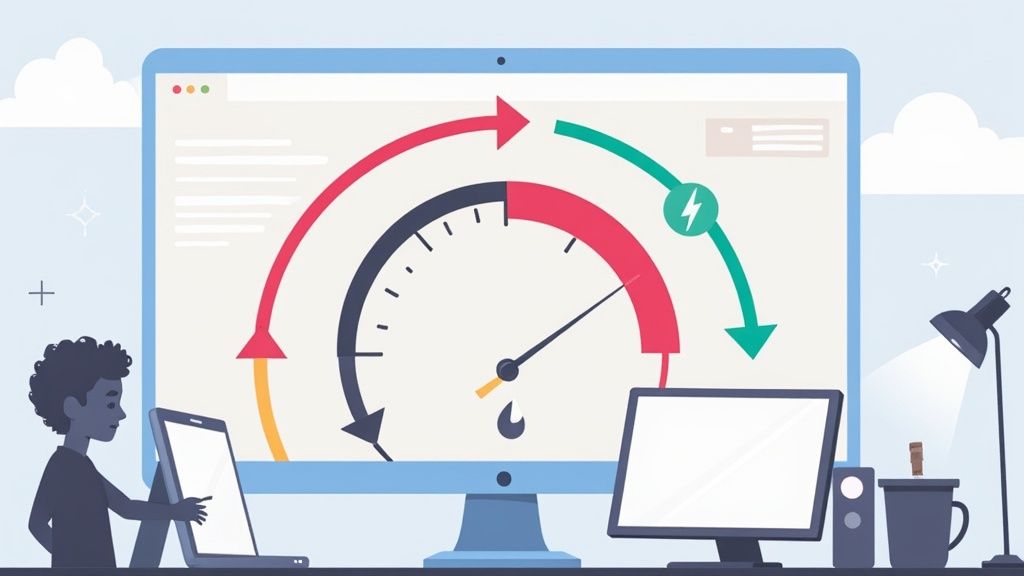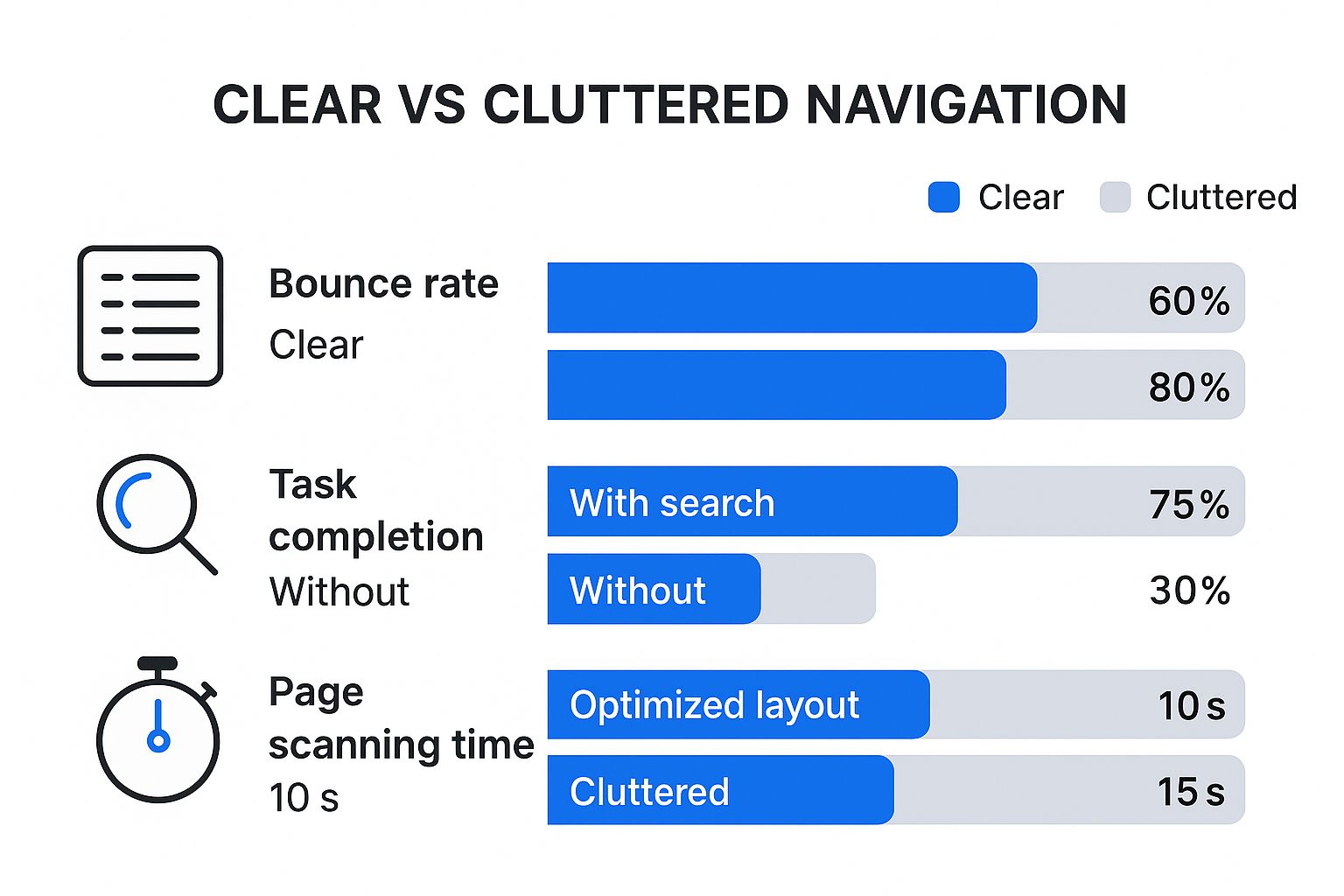
Improving your website’s user experience is all about making your site fast, intuitive, and a breeze to use on a mobile phone. When you nail these things, you’re making it easy and genuinely enjoyable for people to browse, which is what encourages them to stick around and, ultimately, buy from you. Getting these core elements right is the foundation of a successful online business.
Why Great UX Is a Non-Negotiable Asset
Let's be clear: a strong user experience (UX) isn't just a design trend; it's a core driver of business success. When visitors land on your site, they form an impression in milliseconds. A seamless, intuitive design doesn't just look good—it builds trust and has a direct impact on your bottom line.
A positive UX is the difference between a visitor who bounces immediately and one who becomes a loyal customer. It’s about removing friction at every single touchpoint. For instance, platforms are constantly innovating to improve usability, and Mindstamp's new user experience features show how even established tools are always refining things to make their products more intuitive. This commitment to making things better is what separates the winners from the rest.
The Pillars of a Winning User Experience
To really get to grips with improving your website’s user experience, we need to forget the jargon and focus on the practical pillars that hold up a great site. These aren't optional extras; they're the fundamentals.
We'll be diving into the areas that really matter:
- Lightning-Fast Speed: Making sure your pages load almost instantly to stop people from getting frustrated and leaving.
- Intuitive Navigation: Creating a clear, logical structure so users can find what they need with minimal effort.
- Flawless Mobile Performance: Delivering a perfect experience on any device, especially the smartphones where most people are browsing.
- Inclusive Accessibility: Designing your site so that everyone, including people with disabilities, can use it.
Mastering these areas is critical to not just competing, but winning online. A website that is fast, easy to navigate, and accessible to all is a powerful asset that builds brand reputation and drives growth.
Before we get into the details, it's helpful to see how these pieces fit together. This table breaks down the core pillars of UX, what each one aims to achieve, and why it matters directly to your business goals.
Key Pillars of Website User Experience
| Pillar | Primary Goal | Impact on Business |
|---|---|---|
| Usability | Make the website effortless and intuitive to navigate and use. | Reduces bounce rates and increases time on site. |
| Performance | Ensure pages load quickly and interactions are responsive. | Improves user satisfaction and boosts search engine rankings. |
| Accessibility | Design the site so it can be used by people of all abilities. | Expands your audience and demonstrates corporate responsibility. |
| Mobile-Friendliness | Deliver a seamless and optimised experience on smartphones and tablets. | Captures the majority of modern web traffic and improves conversions. |
| Visual Design | Create a clean, professional, and trustworthy aesthetic. | Builds brand credibility and guides the user's journey. |
Ultimately, investing in UX is investing in your customers. When you put their experience first, you create a powerful cycle: visitors are more likely to convert, come back for more, and tell their friends about you.
Mastering Speed and Responsiveness
Let's be blunt: nothing kills a good user experience faster than a slow, clunky website. That tiny delay while a page loads is more than enough time to lose a potential customer forever. Speed isn't just a techy metric; it’s the very first impression you make and a clear signal of how much you value your visitor’s time.
And in the same breath, we have to talk about responsiveness. It’s not optional anymore. Your audience is constantly flicking between phones, tablets, and desktops, and your website has to deliver a seamless, high-quality experience on every single one. A site that looks stunning on a laptop but is a jumbled mess on a smartphone is, for a huge chunk of your audience, fundamentally broken.
Slashing Your Page Load Times
Getting your site to load faster is one of the most impactful things you can do to improve your website's user experience. Every millisecond really does count. A slow site feels unprofessional and frustrating, which leads directly to people giving up and leaving.
Here are a few practical places to start:
- Compress Your Images: Large, unoptimised images are almost always the biggest offenders. Use tools like TinyPNG or your photo editing software to slash file sizes without wrecking the visual quality.
- Leverage Browser Caching: This clever trick tells a visitor’s browser to save static files (like your logo, CSS files, and JavaScript) on their local device. When they come back, the site loads in a flash because it doesn’t have to download everything all over again.
- Minify Your Code: Minification strips out unnecessary characters from your code—things like extra spaces and comments—without affecting how it works. This shrinks the file size, letting it download and run that much faster.
If you really want to get under the bonnet, our comprehensive guide on how to improve website speed is packed with actionable steps to get your site running at peak performance.
Responsive Design Is a Must
A responsive design is one that fluidly adapts its layout to fit whatever screen it's being viewed on. Here in the UK, this is absolutely critical for keeping visitors around. The data is stark: 88% of UK users are less likely to return to a website after a poor experience.
It gets better, though. Websites with proper responsive designs see an average 22% lower bounce rate, and faster sites enjoy a 35% increase in session duration.
Tools like Google's PageSpeed Insights are invaluable for seeing how your site stacks up. They give you a detailed performance report for both mobile and desktop, showing you exactly where the problems lie.
Here’s an example of what that report looks like, highlighting the key performance scores. The report breaks down your site’s performance into Core Web Vitals, offering clear diagnostics and opportunities for improvement.

Your goal should be to get high scores across the board, but pay special attention to mobile. A poor mobile score is a massive red flag. It means you're delivering a rubbish experience to a huge segment of your audience, which directly hits engagement and sales. Investing in speed and responsiveness isn't just a technical task—it's a fundamental business strategy.
Designing Intuitive Navigation and Clear Layouts
A gorgeous website that nobody can figure out how to use is, frankly, useless. Think of it like walking into a beautifully designed library where none of the books are organised. The initial wow-factor quickly turns into pure frustration, and that's exactly what your visitors feel on a confusing website.
A great user experience hinges on making the journey from A to B feel completely effortless. Your website’s navigation is the map that guides them, and the goal is to slash their cognitive load—that’s the mental effort they have to put in to use your site. When people don’t have to think hard about where to click next, they stay longer, look at more pages, and are far more likely to become a customer.
Crafting a Logical Site Structure
A sensible structure starts with putting yourself in your customer's shoes. It’s a common mistake to base your menu on your internal company departments. Don't. Base it on what your customers are actually looking for.
Keep your main navigation menu lean and focused, ideally with no more than seven top-level items. Anything more starts to feel cluttered.
Use simple, universally understood language for your menu labels. Now isn't the time for clever jargon or internal branding terms. "Contact Us," for example, is instantly clear, whereas "Connect With Our Team" makes someone pause for a split second. These tiny moments of friction really do add up and can harm the user experience.
- Breadcrumbs: On more complex sites, breadcrumb navigation is a lifesaver. This simple trail shows users exactly where they are (e.g., Home > Services > Web Design) and lets them jump back a level without mashing the back button.
- Footer Navigation: Your footer is the perfect spot for all those secondary links like "Careers," "Privacy Policy," or "FAQs." It keeps your main navigation clean while making sure the important stuff is still easy to find.
- Functional Search Bar: A prominent and effective search bar is non-negotiable, especially for e-commerce or content-heavy sites. Make sure it delivers relevant results quickly to head off any user frustration.
A well-structured website anticipates what a user needs. The layout should feel like it's naturally guiding them towards their goal, not like it's a puzzle they have to solve.
The Power of Visual Hierarchy and White Space
Beyond the menu, the layout of each page plays a huge role in how usable your site feels. Visual hierarchy is the art of arranging elements on a page to show their order of importance. The most critical information, like your main headline or a call-to-action button, should immediately draw the eye.
You can create this hierarchy using size, colour, and placement. A large, bold headline naturally gets read before the smaller body text. A brightly coloured "Buy Now" button stands out against a more neutral background. To really nail this, exploring proven website design best practices will give you a solid foundation for creating layouts that work.

Finally, never underestimate the power of white space (or negative space). It isn't just "empty" space; it’s an active design element that reduces clutter, improves readability, and creates a sense of calm and focus.
Jam-packed pages overwhelm users, making it incredibly difficult to process information. By giving your content and design elements room to breathe, you make your entire site feel far more accessible and professional.
Optimising for the Mobile-First World
Shifting your design thinking from desktop-first to mobile-first isn't just a trend anymore; it's a fundamental requirement. With most web traffic now coming from smartphones, your mobile site is your primary website. A clunky, frustrating mobile experience isn't just a minor annoyance—it's a clear signal to potential customers that you're not keeping up.
This means rethinking everything from the ground up, starting with how people physically interact with their phones. We're designing for thumbs, not a precise mouse pointer. This simple fact has massive implications for your navigation, where you place buttons, and the entire layout of your pages. Every element has to be easy to see, read, and tap on a small screen, often while the user is distracted or on the move.
Designing for Touch and Thumbs
The first rule of mobile UX is to make every interaction feel effortless. One of the most common and infuriating issues I see is when interactive elements are too small or crammed too closely together. This just leads to mis-taps, frustration, and a swift exit from your site.
To fix this, you need to get obsessed with tap targets. These are the areas on the screen a user can tap to make something happen. They need to be big enough for a finger to hit accurately without accidentally tapping something else nearby.
- Button Size: Make sure your buttons and other tappable links are at least 44x44 pixels. This gives users a generous target to aim for.
- Spacing: Add plenty of breathing room between interactive elements. This is how you prevent the "fat finger" problem where users tap the wrong link.
- Thumb-Friendly Navigation: Place your most important navigation elements—like menus and primary call-to-action buttons—within easy reach of the user's thumb, which is typically at the bottom or lower sides of the screen.
A mobile user's patience is incredibly thin. If they have to pinch, zoom, and struggle to tap a tiny button, they're not just leaving; they're likely heading straight to a competitor with a better mobile site.
The data below shows just how much clearer, more optimised layouts can significantly improve key user engagement metrics.

As you can see, a well-organised mobile layout with easy navigation and search can slash bounce rates and dramatically improve a user's ability to get things done.
Performance and Usability on the Go
Beyond just the layout, mobile optimisation is about understanding the unique context of mobile users. They're often on less stable network connections, which makes performance even more critical. Every bit of data counts, so optimising your images and scripts specifically for mobile is non-negotiable.
This mobile-centric approach is particularly crucial here in the UK, where the average mobile bounce rate is a staggering 67.4%. The opportunity is massive, though, as 67% of mobile users say they are more likely to buy from a mobile-optimised site. Despite this, 66% of UK mobile sites still place tappable elements too close together, and 48% of customers see a poor mobile site as a sign that the business simply doesn't care. You can discover more UK mobile UX statistics to see the full picture.
Of course, the priorities for a mobile user are often different from someone sitting at a desk. We need to design accordingly, focusing on speed and simplicity for mobile, while leveraging the extra screen space for desktop.
Mobile vs Desktop UX Design Priorities
This table highlights the key differences in design focus when creating experiences for mobile and desktop users.
| Consideration | Desktop Priority | Mobile Priority |
|---|---|---|
| Navigation | Extensive menus, mega menus, detailed headers and footers. | Streamlined, often hidden behind a "hamburger" icon; thumb-friendly bottom navigation. |
| Screen Space | Utilise the wider screen for multi-column layouts, sidebars, and rich visual content. | Single-column layouts are standard. Content must be prioritised and stacked vertically. |
| Interaction | Precise clicks with a mouse and keyboard shortcuts. Hover states are important. | Tap, swipe, and pinch gestures with a thumb or finger. No hover states. |
| Performance | Fast loading is important, but there's more tolerance due to stable, fast broadband. | Speed is absolutely critical. Optimise everything for slower mobile data connections. |
| Content | Can display more detailed information, longer text blocks, and complex data visualisations. | Content must be concise and easily scannable. Break text into short paragraphs and use visuals. |
| User Context | Focused, task-oriented sessions. Users are often researching or working. | On-the-go, often distracted, and looking for quick information or to complete a simple task. |
The differences are stark. Designing for each context properly is what separates a good user experience from a great one.
The technical foundation for all of this is a solid, well-built site. It should use a flexible grid that automatically adjusts content to fit any screen size perfectly. For a deeper dive into the mechanics, our guide explains in detail what is responsive web design and why it's so essential for a great user experience today.
Enhancing UX with Personalization and Accessibility
Once you’ve sorted the technical fixes, it's time to focus on the human side of things. This is where you can make the most profound improvements to your website's user experience. It's about creating a site that not only works for everyone but feels like it was made for each individual visitor. This is how you build a genuine connection.
Personalization isn’t about being creepy with data; it’s about being helpful. When you understand a bit about your visitors—like their location or what they've looked at before—you can tailor the content to be far more relevant. This simple act of showing people what they're most likely interested in makes them feel seen and understood, building a powerful connection that generic, one-size-fits-all websites just can't compete with.
Making Your Website Feel Personal
Personalization can be as simple or as complex as you need it to be. For a local Dalkeith business, it could be as straightforward as showing a special offer to visitors from the Midlothian area. For an e-commerce site, it might mean displaying recently viewed items or recommending products based on what they've bought in the past.
These small touches make a huge difference. In the UK market, 66% of consumers say they stop engaging with brands that don’t personalize their experience. That’s a clear signal from users: they want websites that acknowledge their needs, not just treat them as another number in the analytics. To get some ideas on more advanced techniques, check out these dynamic content examples that transform user experience.
Designing for Everyone with Accessibility
Just as important as personalization is accessibility. A truly great user experience has to be an inclusive one. That means designing your website so that everyone, including the one in five people in the UK with a disability, can use it without running into barriers. This isn't just a box-ticking exercise; it's a core part of ethical and effective design.
The great thing is, making your site more accessible often improves the experience for all your users. Here are a few key areas to get right:
- Meaningful Alt Text: Write genuinely descriptive alternative text for all your images. This is essential for users with screen readers to understand the visual content on your page.
- Colour Contrast: Make sure there's enough contrast between your text and background colours. This helps people with low vision read your content without straining.
- Keyboard Navigation: Check that every single interactive element on your site—from menus to forms—can be accessed and used with just a keyboard.
Accessibility isn't an add-on feature. It's a fundamental mindset shift that ensures the digital world is open to everyone, creating a better experience for all your visitors.
The Web Content Accessibility Guidelines (WCAG) provide a clear, internationally recognised framework for getting this right.
Here’s a look at the official W3C page that outlines these critical standards.

This resource is the global benchmark, offering detailed guidance to help you build a more inclusive website that meets established success criteria. By embracing both personalization and accessibility, you create an experience that feels custom-built and universally welcoming—which is the ultimate goal of exceptional UX.
Got Questions About Website UX? We’ve Got Answers.
Diving into user experience can feel like opening a can of worms. It’s one thing to get your head around the principles, but it’s another thing entirely to apply them with confidence. We get a lot of the same questions, so we’ve gathered them here to give you some clear, straightforward answers.
Think of this as your quick-reference guide. We’ll cut through the jargon and give you the practical insights you need to start making some real improvements to your website.
What Is the First Thing I Should Fix for Better UX?
If you can only tackle one thing right now, make your website faster. Page speed is the very first impression you make, and a slow site is an absolute non-starter for most people. A delay of just a couple of seconds is enough to send your bounce rate through the roof.
Before you start agonising over colours or fonts, make sure the technical foundations are solid. Optimising your images, using decent hosting, and tidying up your code will give you the biggest and most immediate bang for your buck. Everything else is built on top of that.
How Is UX Different from UI?
This is a classic point of confusion, but the distinction is actually quite simple. The easiest way to think about it is that the User Interface (UI) is the 'what', while the User Experience (UX) is the 'how it feels'.
- UI (User Interface): This is all the visual stuff a user clicks, taps, and looks at. We’re talking about buttons, icons, typography, and colour schemes. It’s the aesthetics and the surface-level look of the site.
- UX (User Experience): This is the overall feeling someone gets while using your site. It covers their entire journey—the logic of the navigation, the loading speed, and how easy it was for them to get what they came for.
A beautiful button (UI) is completely useless if the user can't figure out where it is or what it’s supposed to do (UX). Great design needs both to work in perfect harmony.
How Do I Know If My Website Has Bad UX?
Your users are already telling you, just maybe not in words. The data holds all the clues. Sky-high bounce rates, low time on page, and abandoned shopping carts are all classic signs of a frustrating user experience.
You can also use a few tools to get a clearer picture. Heatmaps will show you exactly where people are clicking (and, more importantly, where they aren't), which is a brilliant way to spot confusion. Session replay tools are even more powerful; they let you watch recordings of actual user journeys, highlighting the exact moments they get stuck or give up.
Can Good UX Really Impact My Sales?
Absolutely. There's a direct and measurable line connecting a positive user experience to your bottom line. A site that’s a breeze to navigate and quick to load removes all the friction from the buying process, which naturally makes conversions more likely.
Put yourself in your visitor's shoes for a moment. If they can find a product, understand what it does, and check out in a few simple steps, they are far more likely to see the purchase through. Every single obstacle you remove is a potential sale saved. A seamless experience builds trust, and trust is what turns a casual browser into a paying customer.
At Altitude Design, we specialise in building custom, high-performance websites that deliver an exceptional user experience from the ground up. If you're ready to turn your website into a powerful asset that drives real results for your business, we can help. Learn more about our web design services.